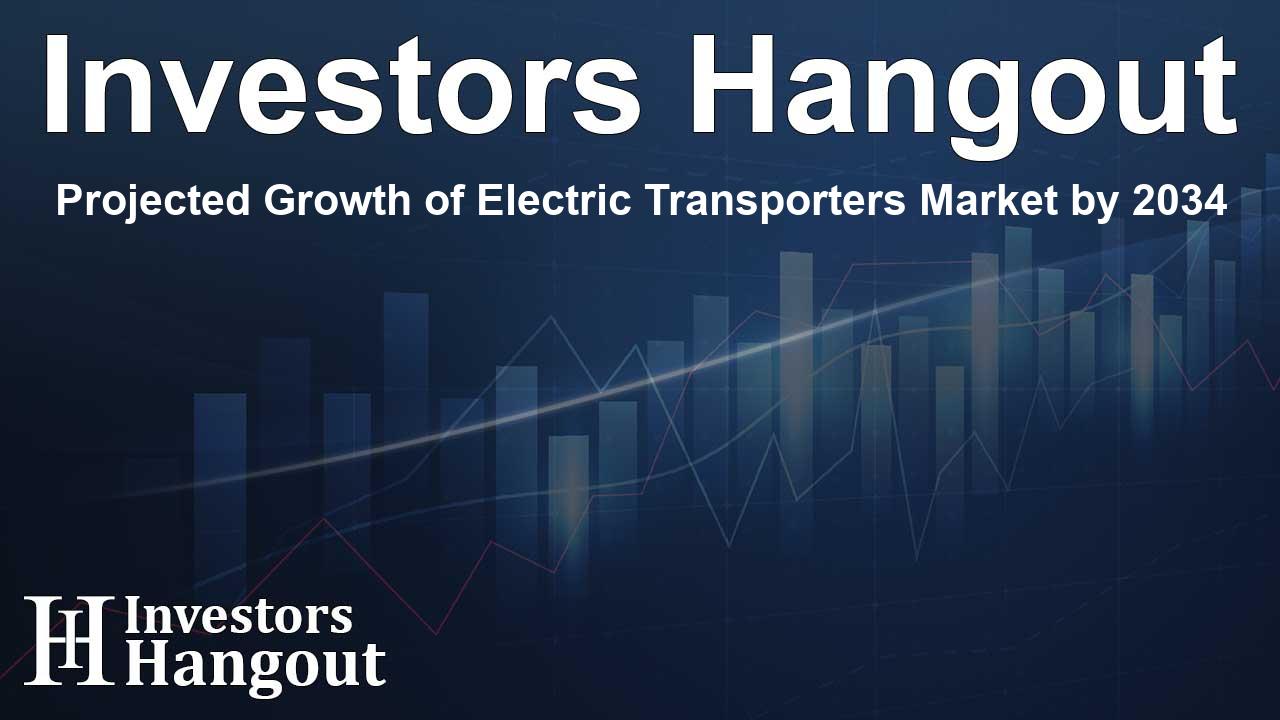Projected Growth of Electric Transporters Market by 2034

The Electric Transporters Market Growth Forecast
The electric transporters market is anticipated to witness remarkable growth, with its valuation expected to soar to USD 108.9 billion by the year 2034. This upward trajectory signals a significant transformation in the transportation sector, where electric vehicles are rapidly becoming a preferred mode of travel.
Factors Driving Market Growth
Several factors are contributing to the burgeoning growth of the electric transporters market. The rising prices of traditional fuels are prompting both individuals and businesses to explore cost-effective electric alternatives. This shift is not merely a trend but a necessity, driven by stricter emission standards and robust environmental policies. Urban regions, in particular, are seeing a sizable transition to electric transport, being incentivized by low-emission zones, carbon taxes, and various incentives designed to encourage electric vehicle adoption.
Regional Emphasis on Electric Vehicle Adoption
In regions like Europe and parts of Asia, ambitious zero-emission targets are reshaping transportation infrastructure, leading to a marked increase in the adoption of electric bikes and other electric transport options. Favorable regulations and financial incentives are supporting this transition and enhancing safety measures for e-vehicles.
Market Segmentation Insights
Within the electric transporters market, notable segmentation exists between two-wheelers and personal transporters. Currently, two-wheelers dominate the market, holding an impressive 95% share. Projections indicate that this segment may generate up to USD 103.5 billion by 2034. One pivotal development fuelling growth in this area is the establishment of standardized battery-swapping networks, which prove essential for the practical use of e-scooters and e-motorcycles in urban environments.
Battery Technologies Driving Innovation
The market's segmentation further extends into battery types, including lithium-ion, lead-acid, nickel-metal hydride, and solid-state batteries. By 2034, lithium-ion batteries are projected to command a market size of USD 78.5 billion, paving the way for innovation in battery chemistry. Newly developed lithium-ion technologies, such as Lithium Iron Phosphate (LFP) and Nickel Manganese Cobalt (NMC), are fine-tuning battery performance for various applications. LFP batteries, known for their cost efficiency and longevity, are particularly beneficial for commercial uses despite their lower energy density.
On the other hand, high-nickel NMC formulations offer properties that cater to applications demanding higher energy density, making them ideal for electric transporters that prioritize range and power. This diverse array of battery options allows manufacturers remarkable flexibility, enabling them to tailor battery characteristics according to the specific requirements of their vehicles. This flexibility is crucial as it promotes wider adoption of electric transporters across diverse segments.
China's Role in the Electric Transporters Landscape
As of the latest observations, China holds a commanding position in the electric transporters market, accounting for approximately 65% of the share. The country's accelerated rollout of battery-swapping networks, especially for commercial transporters, has fueled this growth. Numerous companies are responsive to this trend, establishing automated swap stations within urban territories to facilitate quick battery exchanges for delivery vehicles and taxis. These innovative stations can replace depleted batteries with fully charged ones in under five minutes, markedly reducing operational downtime and enabling continuous vehicle use.
Government Support for Infrastructure Development
Additionally, the Chinese government's supportive policies and subsidies are pivotal in advancing the establishment of a national battery-swapping infrastructure, fostering an environment that eases electric vehicle adoption and further enhancing market growth.
Conclusion and Future Outlook
The electric transporters market is on a trajectory of significant growth, reshaping the transportation sector. With continued innovation in battery technologies and supportive governmental policies, the shift towards electric vehicles is not just a fleeting moment in time but a long-term evolution that stands to redefine how individuals and businesses approach transportation.
Frequently Asked Questions
What is the projected market size for electric transporters by 2034?
The electric transporters market is expected to reach USD 108.9 billion by the year 2034.
Which region is currently leading the electric transporters market?
China is the leader of the electric transporters market, holding a significant share of around 65%.
What factors are influencing the growth of the electric transporters market?
Key factors include rising fuel prices, stringent emission regulations, and increased adoption of battery-swapping technology.
What types of electric vehicles dominate the market?
Two-wheelers currently dominate the market, accounting for about 95% of the market share.
How are battery technologies evolving in the electric transporters market?
Lithium-ion battery technologies are evolving with innovations such as Lithium Iron Phosphate and Nickel Manganese Cobalt, enhancing performance for electric transport applications.
About Investors Hangout
Investors Hangout is a leading online stock forum for financial discussion and learning, offering a wide range of free tools and resources. It draws in traders of all levels, who exchange market knowledge, investigate trading tactics, and keep an eye on industry developments in real time. Featuring financial articles, stock message boards, quotes, charts, company profiles, and live news updates. Through cooperative learning and a wealth of informational resources, it helps users from novices creating their first portfolios to experts honing their techniques. Join Investors Hangout today: https://investorshangout.com/
Disclaimer: The content of this article is solely for general informational purposes only; it does not represent legal, financial, or investment advice. Investors Hangout does not offer financial advice; the author is not a licensed financial advisor. Consult a qualified advisor before making any financial or investment decisions based on this article. The author's interpretation of publicly available data shapes the opinions presented here; as a result, they should not be taken as advice to purchase, sell, or hold any securities mentioned or any other investments. The author does not guarantee the accuracy, completeness, or timeliness of any material, providing it "as is." Information and market conditions may change; past performance is not indicative of future outcomes. If any of the material offered here is inaccurate, please contact us for corrections.